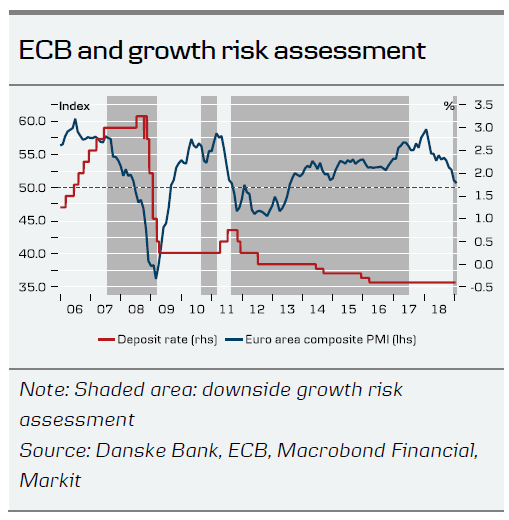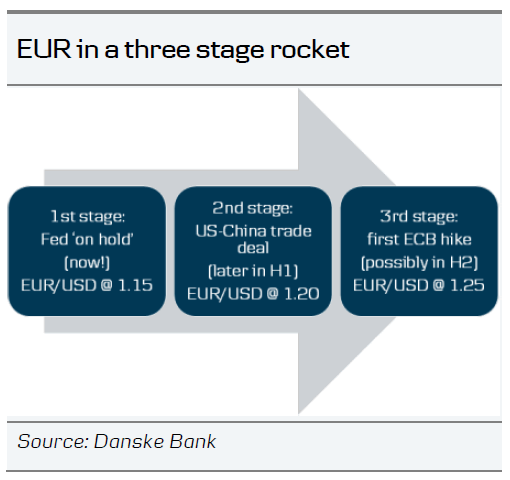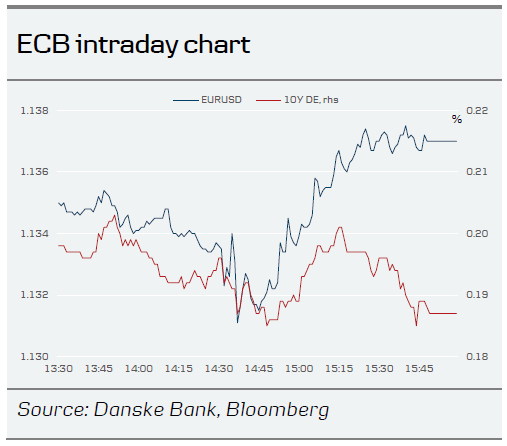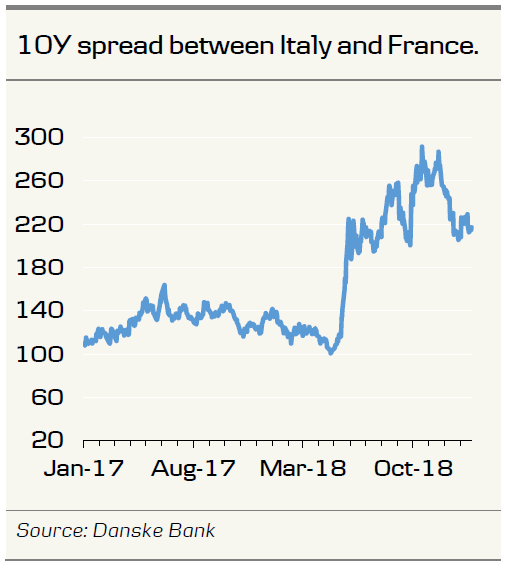- Today, the ECB did not take any new decisions at its governing council meeting.
- It changed its growth risk assessment to be on the downside, along our non-consensus call.
- The ECB did not take a decision on the liquidity situation. Despite this, we keep our call for another liquidity round announced in March and implemented in June.
Uncertainty prevails
In line with our non-consensus call, ECB changed the growth risk assessment – unanimously – to the downside in light of continued weaker incoming data and persistent global uncertainties. This has been long overdue in our view and with January PMIs released earlier today just showing another strong dip, a balanced risk assessment would clearly have challenged the ECB’s claim of being data-dependent. Despite of this, the likelihood of a recession in the euro area was still seen as ‘low’ by the GC members due to favourable financial conditions, lower energy prices as well as the strong labour market developments supporting domestic demand. Mario Draghi hinted that the GC will reassess the implications from the slowdown for monetary policy at the March meeting. So far ECB’s confidence for a wage-driven pick up a in core inflation remains clearly intact, although Draghi cautioned that the pass-through might take longer if the economic slowdown proves more persistent. This clearly points to a output-gap dependent modelling framework in the ECB.
Forward guidance – both date and state dependent
The ECB’s decision was clear in both its date and state dependent aspect of the forward guidance. Markets are currently pricing the first rate hike by 20bp in 22 months (October 2021). Draghi stressed that when markets price a first rate hike in 2020 they are correct as they use the state dependent part of the forward guidance. As Draghi said, “markets understood the reaction function”. Furthermore, Draghi repeated his reverse psychology argument (which he introduced in December) implying that no expectations for rate hikes in near the future supports the inflation and growth outlook.
That said, given the state dependent emphasis by Draghi, it is also important to stress that it also implies that if the economy picks up (as implied by the December staff projections), markets will have to reassess the pricing as rate hike is on the table. We therefore keep our ECB rate call for December by 20bp. We find the ECB pricing too dovish.
Liquidity operation
On liquidity operation, Draghi was not as clear as we had expected and struck an ambiguous tone. ‘Several speakers’ mentioned the TLTRO but ECB is still assessing the impact on the liquidity situation approaching the summer. Furthermore, Draghi was very conscious of linking a potential new liquidity operation as a monetary policy transmission tool. We do not think a new liquidity operation is as clear cut as market participants suggest (some 90% expect liquidity operation in March).
That said, with the NFSR approaching and a fragile banking sector in parts of the euro area, we stick to our call for a March announcement of LTRO, but with less probability than prior to the meeting. We assign a 75-80% probability of liquidity operation announcement in March.
EUR/USD: reluctant support from ECB
ECB’s eagerness to get started was evident today in both Draghi’s upbeat tone despite the downside risks assessment and in the EUR reaction. While EUR/USD initially traded lower during the press conference it still held above the 1.13 mark, even if we did at the same time have the statement from US commerce secretary, Ross, that US and China are far away from each other on trade deal – even if there is a ‘fair’ chance they may eventually reach one – which helped weigh on EUR/USD at first. In the end however, Draghi’s still decently upbeat tone on inflation and his reluctance to commit to new liquidity operations, cemented that ECB remains on course for a hike in the ‘not too distant’ future. To us, EUR/USD still looks like a 1.15 range near term. Indeed, a higher range is now warranted than was the case just a few months by a move higher in EUR-USD real interest-rate spreads as the Fed has arguably largely withdrawn USD support by now. Do we have genuine EUR support from ECB? We still think the first hike is a tad too distant/fragile for FX markets to send EUR significantly higher, but as H1 progresses, we expect the next stage in a EUR/USD rebound to reached via a US-China trade deal. Associated CNY appreciation would further help keep the effective EUR from strengthening too much which would in turn pave the way for ECB. For true lift-off in EUR/USD towards the high 1.20s as warranted by valuation, we need to get closer to confirmation that the ECB intends to move on rates – and that will likely not happen until H2, but we are gradually moving in that direction (see chart).
A “dovish” twist sends bond yields lower
The comments from ECB’s Draghi initially sent bond yield lower despite that we had already seen a decent rally in both core-EU and Periphery.
Given the tilt towards downside risks on the growth assessment, then the positive performance in the periphery should be sustained despite that a weaker growth outlook is not really helpful for e.g. the Italian economy. Hence, the 10Y spread between Italy and France is likely to break below the 220bp, which has been the lower bound since the start of the clash between Italy and EU last year.
We have expected that the Bunds should be range-trading between 0.25% to 0.75% during 2019 as we have seen since mid-2016. We still believe that range will hold for 2019 even though we have broken through the lower bound of the trading range. The comments from the ECB meeting today indicates it could take some time before we move back towards the middle of the trading range
















